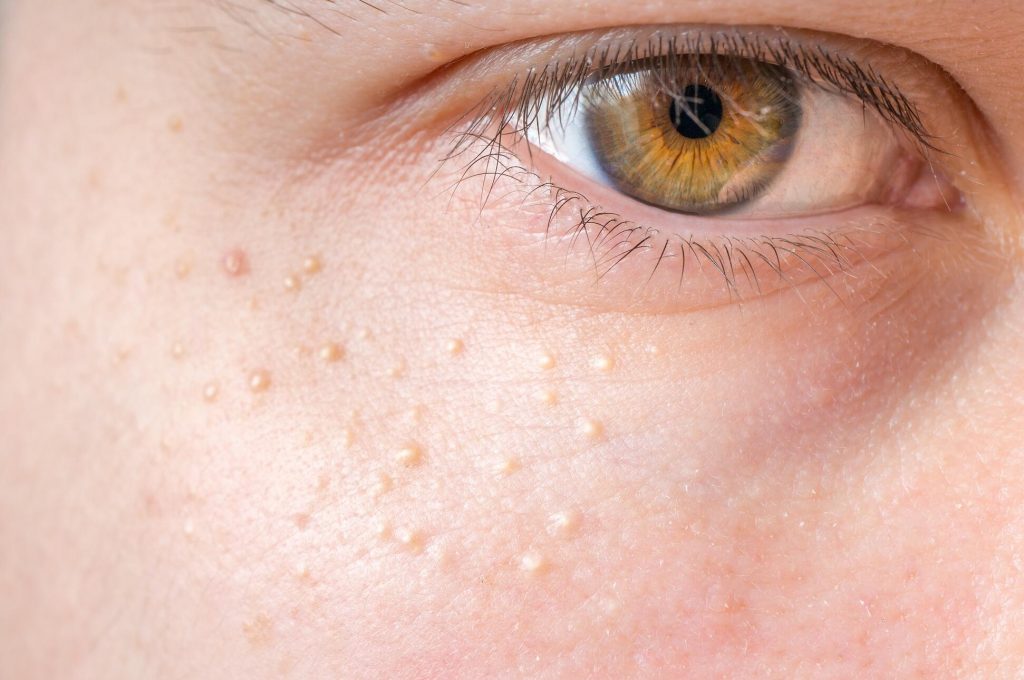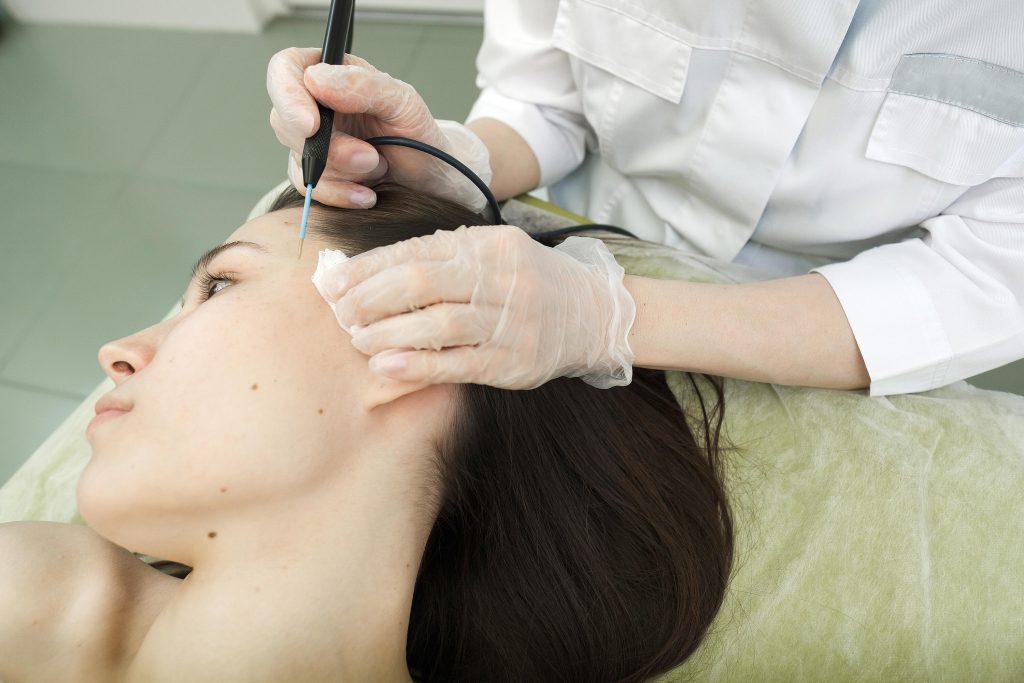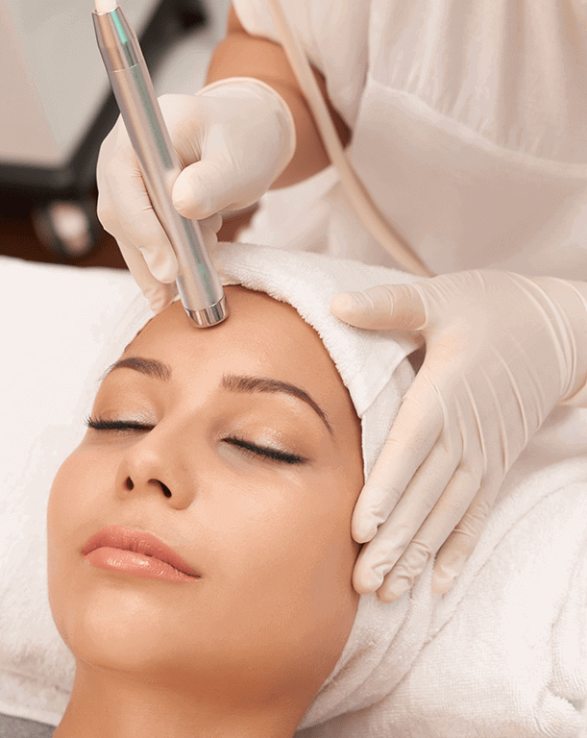Are you noticing bumps on your face that don’t quite look like pimples but are textured? They aren’t really red and inflamed yet they appear in a group on your face? Chances are, you are experiencing milia. They are easily confused with other skin conditions like comedones, miliaria and cysts. They are a very common skin condition that is easily treatable. Read about how they are caused and how you can prevent and treat them.
A milium or multiple milia are small cysts or bumps that form when bits of skin protein, known as keratin, get trapped under the surface of the skin. They usually bunch around the eyelids, nose, cheeks and lips though they can even appear in the mouth and groin area. They are neither red nor painful but these tiny white bumps can sometimes be itchy. They are spontaneous and benign spots that do not pose more threats than just bumps.

Milia form when specks of keratin getting trapped under the skin, at the base of a hair follicle or sweat gland. Keratin is one of the proteins in your skin that helps to form the toughness in the skin.
Milia form when the skin cells turnover rate is slower than usual causing a buildup of keratin under the skin. This is known as primary milia. For adults with milia, it is usually from overexposure to the sun that results in a leathery skin texture, which makes it difficult for the skin to expel keratin from the skin.
There are a few types of milia that occur in both children and adults.
Neonatal milia are considered primary milia that are common with newborn babies. They can appear anywhere on the baby from the scalp to the upper trunk to inside the mouth and other areas of the face and body.
If the bumps appear on the roof of the mouth and gums, they are known as Epstein pearls or gingival cysts. They occur with about 80% of newborns and do not require treatment as they usually dissolve away in the coming weeks.
MEP is a rare and uncommon version of milia due to genetic or autoimmune skin disorders like discoid lupus erythematosus or lichen planus. It is characterized by multiple milia on an inflamed wound usually found on the eyelid, behind the ear, on the cheeks or jaw area. This type can affect both children and adults.
This type of milia consists of itchy bumps on the face, upper arms and torso. The cysts often appear over a span of time, ranging from a few weeks to a few months. They may be red and inflamed depending on the severity of the condition.
Traumatic milia, also known as secondary milia, follows after skin trauma as it clogs the ducts leading to the skin surface like:
Some rare genetic disorders can lead to milia which are categorised as juvenile milia. They can appear at birth or a few years later in older children. These can include:

Although rare, the use of certain steroid creams can sometimes cause milia to the area cream is applied. Some creams like phenols, hydroquinone, 5-fluorouracil cream, and a corticosteroid are just some examples.
Some people have sensitivity to certain ingredients used in skin care and makeup products which also cause them to develop milia. If you have sensitive skin, avoid products with the following ingredients:
Milia is difficult to prevent, especially since it emerges with newborns from birth anyway. However, with adults, it could be reduced and managed by:
Depending on the kind of milia you are experiencing, there may be different cures. In most cases, milia do not have long term implications on the skin as they typically disappear on their own for both babies and adults. However, if you wish to speed up the recovery process, there are professional treatments to treat adult milia.

This is a professional procedure where a small handheld tool produces minor electric currents which are used to remove the unwanted growth. Electrocautery is a multi-functional treatment procedure that can be used to heal milia, brown spots, skin tags and warts. You may need just one to two treatments to fully recover the skin.
Electrocautery is an extremely fast, safe and efficient method when there is precision. Therefore, it is crucial to get an experienced dermatologist to lead the procedure. At Nuffield Aesthetics, we ensure safety for all procedures. Our aim is to make you feel the most comfortable before, during and after your treatment.
A chemical peel, also known as a skin peel, is a more dermatological approach to get rid of milia. Chemical peels use certain acids called Alpha Hydroxy Acid (AHA) and Beta Hydroxy Acid (BHA) to get rid of dead skin cells. It removes the topmost layers of the skin by mildly irritating the skin. The use of acids, helps to break down any dirt or bacteria that has formed on the skin, exfoliating it and encouraging new skin cells to grow, giving a healthier and more rejuvenated look to the skin.
There are a few types of chemical peels which use a spectrum of acids ranging from mild to strong. You will be recommended on the kind of chemical that is best suited for your skin. Some common acids used are glycolic acids and salicylic acid.
At Nuffield Aesthetics, we provide chemical peels to help rejuvenate your skin and remove the milia. Read more about our chemical peels here.

The CO2 laser is a common resurfacing treatment for skin conditions like acne and wrinkles. However, they can be used to treat milia as well. Ultra pulse CO2 laser, due to its ultra-short pulses, delivers an ablative effect with minimal thermal damage by removing thin layers of skin, allowing new skin to rejuvenate from within. CO2 laser poses little to no threat of damaging the skin. You may be required to give your skin a few days of downtime but do not need any more commitment for the recovery of your skin. Once treated with laser, milia generally do not recur very fast but new milia may still develop over time.
At Nuffield Aesthetics, we provide CO2 laser treatment for skin conditions like milia, acne, wrinkles and sunspots. Read more about the technology we use and how it may work for your skin condition.
Cryotherapy, also known as cryogenic therapy, is a form of treatment that uses freezing or near-freezing temperatures to destroy abnormal cells. This can include cryosurgery, or cryoablation, where liquid nitrogen kills tumours or cancerous cells. Some forms of cryotherapy include facials and ice bath immersion.
Dermatologists will use a clean needle to poke the tiny flap of skin trapping the keratin inside the pore and squeeze out the flake.
Although a less-common practice is a cure, the procedure involves surgical scraping off each milium milia then sealing the skin with a hot wire with the use of a spoon-shaped tool with an edge called a curette.
If you have milia and are bothered by it, Nuffield Aesthetics offers you a variety of treatments to help cure the issue. With our friendly aestheticians and experienced dermatologist, you will be able to get an individualised treatment plan that works well for your skin.